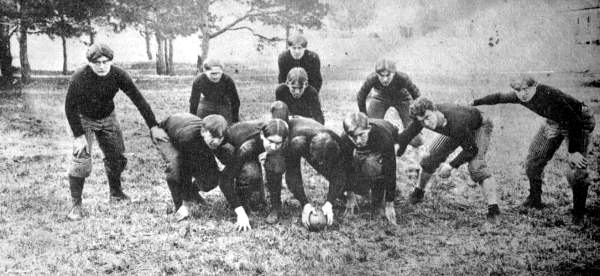
President Teddy Roosevelt saved football.
No wonder he’s on Mount Rushmore.
During TR’s presidency in the first decade of the 20th century, college football had become increasingly popular. It had also become brutally dangerous. Safety features were minimal. Leather helmets provided only modest protection. “Real” football meant strapping young men running into each other at great speed, with no regulations governing unnecessary roughness, holding, or crippling cheap shots.
More than a hundred college players died during football’s early years. University presidents began to disband their teams.
Since Roosevelt adored football, and one of his sons played for Harvard, he convened a special White House football summit in 1905.
His message? Football’s rules-makers could either reform the sport by making it safer, or he would consider making it illegal. “Get the game played on a thoroughly clean basis!” TR roared.
A new rules committee was created. One of its members advocated an idea long promoted by legendary coach John Heisman (for whom the trophy is named): Why not make it legal to throw the football? Perhaps that would open up the field and prevent massive midfield pileups, with all their attendant injuries.
It’s worth noting that many people thought the forward pass would ruin the game. The chair of the rules committee was opposed to it. The New York Times called the proposal “radical.”
The public outcry for safety, however, ruled the day. The pass became legal in time for the 1906 college football season.
This is not to say that aerobatics suddenly took over the game. The purists among the rules-makers were able to place heavy restrictions on passing. You couldn’t throw the ball unless you were at least five yards away from the center. An incomplete pass was counted as a turnover. Incredibly, it was illegal to complete a pass in the end zone.
But all that would eventually change, and Tom Brady, Aaron Rodgers, Joe Burrow and Patrick Mahomes would have a reason to bring their special talents into the world. Football would never be the same.
Why is it so hard to embrace what is New and Improved?
Almost everything about the human condition resists change. Here we’re acknowledging what neurologists call “stasis” – the strong preference of our brains to keep doing things we already know how to do. Organizations and groups favor stasis as well. Who hasn’t heard – whether in the boardroom, the family room, or the sanctuary – “we’ve never done it that way before”?
Spiritual vitality respects tradition, but not traditionalism. The former has been described as the living faith of dead people, while the latter is the dead faith of living people.
There’s a notable bias in Scripture toward what is new. Consider Isaiah 43:18-19: “Remember not the former things, nor consider the things of old. Behold, I am doing a new thing; now it springs forth, do you not perceive it? I will make a way in the wilderness and rivers in the desert.”
God is committed to transforming what is barren and infertile in our lives – the wilderness places of our hearts – into gardens where hope can find a fresh foothold.
But there’s something in most of us – something that might sound like a nit-picky rules committee – that will whisper, “Things are just fine. Stasis is your friend. Where did you ever get the idea that you could change, anyway?”
Refuse to listen. Stop up your ears. Choose to do something out of your comfort zone: Throw a forward pass.
And maybe, just maybe, root for the Colts to sign a new quarterback before the vernal equinox.
